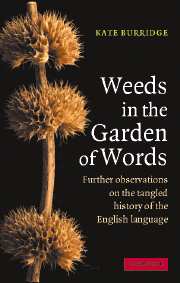Book contents
- Frontmatter
- Contents
- Acknowledgments
- Introduction to the Weedy Traits of the English Language
- Our Lexical Weeds: the World of Jargon, Slang and Euphemism
- More Lexical Weeds: Word Origins and Meaning Shifts
- Our Grammatical Weeds
- Weeds in Our Sounds and Spelling
- The Truly Nasty Weeds of the English Language?
- W(h)ither Our Weeds?
- Bibliography
- List of Interesting Words
Weeds in Our Sounds and Spelling
Published online by Cambridge University Press: 22 September 2009
- Frontmatter
- Contents
- Acknowledgments
- Introduction to the Weedy Traits of the English Language
- Our Lexical Weeds: the World of Jargon, Slang and Euphemism
- More Lexical Weeds: Word Origins and Meaning Shifts
- Our Grammatical Weeds
- Weeds in Our Sounds and Spelling
- The Truly Nasty Weeds of the English Language?
- W(h)ither Our Weeds?
- Bibliography
- List of Interesting Words
Summary
A really long day of weeding is a restful experience, and quite changes the current of thought. For some people it is more efficient than a rest cure … After such a day my fingers are bleeding, knees tottering, back bent, dress muddy and soaking, and shoes an offence to my tidy maid; but I have attained the most profound inward peace, and the blessed belief of having uprooted all my enemies.
Anna Lea Merritt An Artist's Garden 1908Evidence for early pronunciations
Before I start looking at some of our phonological weeds, let me address something that I know puzzles many people about pronunciations of the past. How do we figure out the early pronunciation of words in our language? We have no time machine to take us back through history to investigate the spoken language of our forbears. And we can't drag Old and Middle English speakers out of cold storage and ask them.
Yet we can be quite confident about early English pronunciations. The evidence comes from a number of different sources. For a start, we know a good deal about the workings of articulation and therefore also about how sounds change. We have a good idea of what are likely and unlikely sound changes, for instance. We also have dialect material at our disposal. Dialects can be conservative, and often shed light on pronunciations that have disappeared elsewhere.
Spelling also offers nice clues.
- Type
- Chapter
- Information
- Weeds in the Garden of WordsFurther Observations on the Tangled History of the English Language, pp. 120 - 164Publisher: Cambridge University PressPrint publication year: 2005



